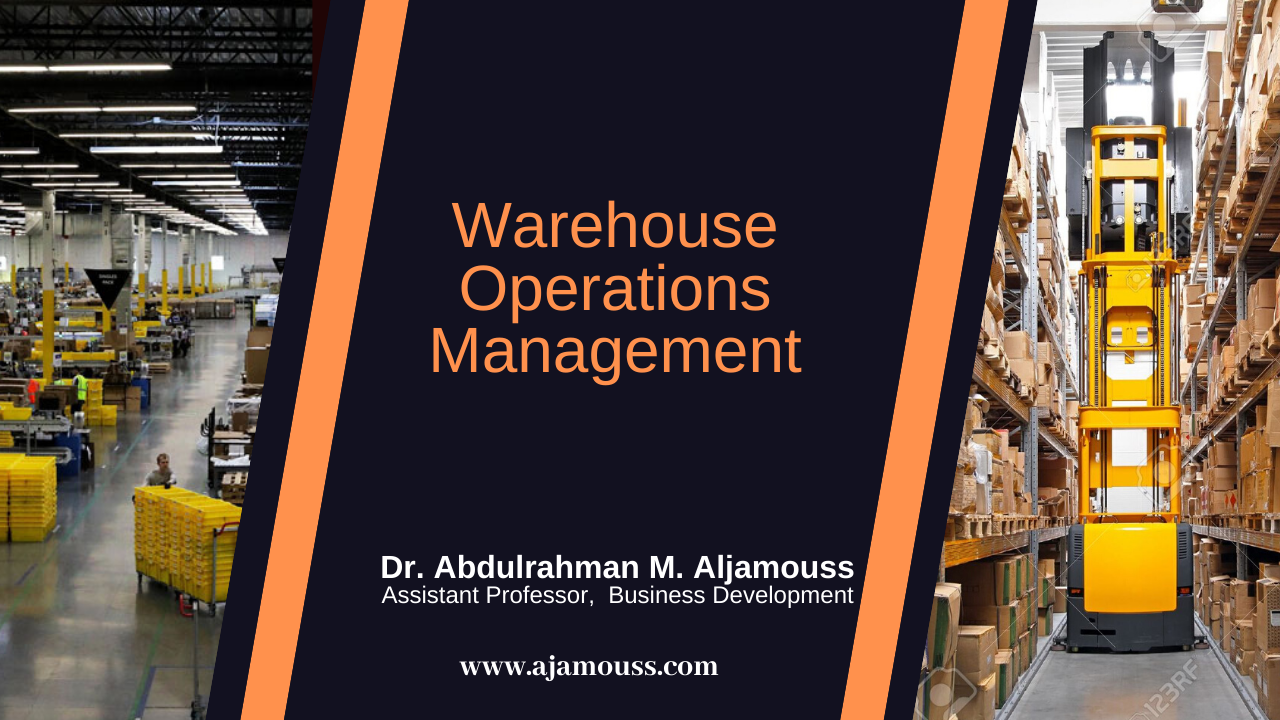Warehouse Operations Management
Warehouse Operations Management
Dr. Abdulrahman M. Aljamouss
Assistant Professor, Business Development
The economic importance of Warehousing:
- Economic utility of Warehousing
- The value in achieving customer needs or wants.
- Possession utility:
- The product can be owned by the customer.
- Place utility:
- Products available where they are needed by customers.
- Time utility:
- Products available when they are needed by customers.
Importance of Warehousing
- To achieve transportation economies
- To take advantage of quantity purchase discounts
- To support the firm’s customer service policy
- To meet the changing in market conditions
- To accomplish least total cost logistics.
Logistics in the Economy
- United States Business Logistics Costs reached $1.6 trillion in 2018
- United States Business Logistics Costs reached 8 % of GDP.
Logistics in the Manufacturing Firm :
-
- Logistics Cost 21%
- Marketing Cost 27%
- Manufacturing Cost 48%
Examples :
-
- Boeing announced a $2.6 billion deleted in 1997 because “raw materials shortages”
- S Surgical Corporation announced a $22 million loss in 1993 because “larger than expected inventories”
- HP and Dell found it difficult to get important components from Taiwanese suppliers in 1999 because a massive earthquake.
Why a warehouse?
- To store:
- Raw materials and components
- Work in process materials
- Finished goods
- warehouse is a very expensive
- (between 2-5% of sales of corporation)
Every warehouse has a target:
- To give the right product
- To the right customer
- In the rights conditions
- With the right quality
- In the right time
- At the right costs
- With the right information
Warehouse management Goals
- Maximize effective use of space.
- Maximize effective use of equipment.
- Maximize effective use of labor.
- Maximize accessibility of all items.
- Maximize protection of all items.
- Maximize effective use of information.
- Maximize the protection of company’s assets.
- Minimize goods handling.
- Minimize the company operating Cost.
Warehouse Functions
- Unloading
- Receiving & Checking inbound goods
- Internal product movement
- Storing
- Order-picking
- Stock Sortation
- Stock Rotation
- Packing
- Loading & Shipping
- Cycle Counting
- Replenishment
- Handling Returns
- Maintenance
Public, Private, Contract, and Multiclient Warehousing
- Public warehouses , Provides short or long-term storage to companies on a month-to-month basis
- Private warehousing, Mostly owned by big companies. Can be operated as a separate division within a company.
- Contract Warehousing, is a 3rd party storage facility which offers specialized storage services.
- Multiclient warehousing, Outsourced management of warehousing operations to a facility that is typically shared with multiple clients
Shelf life management
- What is shelf life?
- Time necessary for the item to loss 90% of its original concentration.
- First-expired-first-out (FEFO) inventory logic
- Information-rich barcodes
- Minimize Wastage With FIFO
- shelf life data includes:
- Maximum time a material can be stored
- Minimum shelf life a material must have available to be accepted by the system
- % of the total shelf life that must still be available if the goods are to be sent to another distribution point
- Time unit used for the shelf life data (days, weeks or years)
- Total number of days that the goods can be kept – from production to the shelf life expiration date
Reducing costs in inventory management
- Reduce Consumption – Stop Waste, Theft
- Reduce Inventory Carrying Costs
- Cut Spend on New Tools – Force use of Reconditioned Items
- Reduce Obsolete Inventory
- Reduce and Eliminate Stock-Outs
- Reduce or Eliminate Purchase Orders
- Reduce Support Staff Costs
Controlling backorder
- A backorder is a product that is out of stock at the moment but is promised to ship once available (with a date often provided).
- Backordered means the shopper can buy the item now and receive it at a future date.
- Backorders happen for a variety of reasons :
- Unusual demand
- Low safety stock
- Manufacturer or supplier problem
- Controlling backorder levels
- Set safety stock
- Calculate and set reorder points
- Regularly view inventory levels of popular items
- Have multiple suppliers
- Order more product
ABC Always Better Control (ABC) Analysis
What is ABC analysis?
- ABC analysis is an inventory categorization method which consists in dividing items into three categories (A, B, C):
- Classifying inventory according to some measure of importance and allocating control efforts accordingly.
A - very important
B - mod. important
C - least important
A Pareto analysis
- A Items – typically 20% of the items accounting for 80% of the inventory value-use Q system
- B Items – typically an additional 30% of the items accounting for 15% of the inventory value-use Q or P
- C Items – Typically the remaining 50% of the items accounting for only 5% of the inventory value-use P
- A being the most valuable items, C being the least valuable ones. This method aims to draw managers’ attention on the critical few (A-items) not on the trivial many (C-items).
Warehousing Operations issues
- Some operational issues include:
- Warehousing productivity
- Safety considerations
- Hazardous materials
- Warehousing security
- Cleanliness and sanitation issues
